A Fish Caught in a Spider’s Web? Something Seems Off in This Picture. Did the fish jump ashore, or does the spider know how to dive underwater, spinning webs to enhance its meal?
The second possibility seems more likely. In this image, we can see that the spider silk is attached to aquatic plants. And if you look closely, you will also notice that the spider has constructed a bubble home underwater.
What could be more surprising than a species of spider (which lacks gills to breathe underwater) that can still live, hunt, and even mate and reproduce underwater? In this article, we will explore how the Argyroneta aquatica – the most unusual spider on the planet accomplishes this.
The Diving Art of the Argyroneta aquatica Spider
For a typical spider, falling into water can mean death. It would quickly suffer from hypothermia, lack of oxygen, and even become prey for aquatic animals.
But for the A. aquatica, also known as the “dive bell spider“, being underwater is its preferred habitat.
First, let’s talk about the name – why is it called the dive bell spider? This is because this creature mimics a diving technique used by humans (or perhaps humans have imitated them – who knows?).
As early as the 4th century BC, Aristotle described how divers would drop a bell underwater to trap air inside it, creating a breathing station while exploring underwater.
Even Alexander the Great (356 BC – 323 BC), Aristotle’s great student, used a glass bell to dive during his ocean explorations.
He even brought along a dog, a cat, and a rooster on this special journey – these animals were fortunate enough to be the first representatives of their species to dive to the ocean floor.
Returning to the A. aquatica spiders, they do not need to follow Alexander the Great to explore the underwater world. This spider can create its own dive bells.
The clever strategy of the A. aquatica spider is executed as follows:
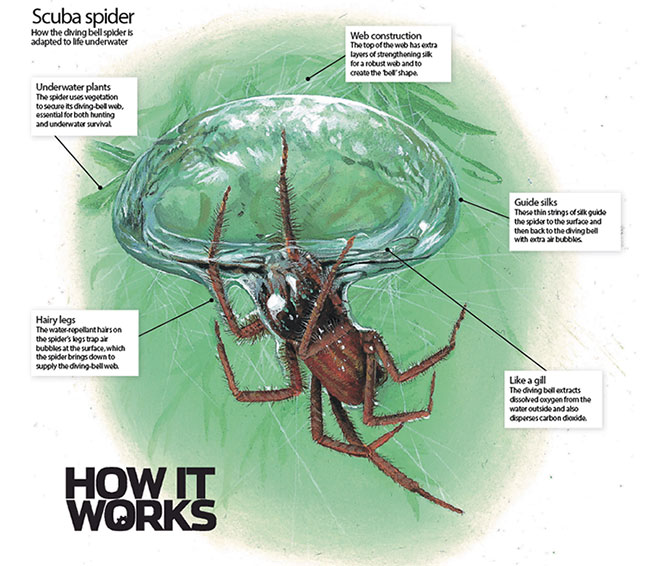
For this species, being underwater is its preferred habitat.
First, it dives underwater and looks for some aquatic plants to spin its silk on. But instead of expanding its web on a flat surface like other spiders, the A. aquatica spider wraps its silk in layers like a 3D printer, creating an inverted silk bell underwater.
Next, the spider swims back to the surface, continuing to spin silk to create a ladder connecting the bell below and the surface above. The next step is to transport air from the surface and pour it into the bell below.
How do you think the A. aquatica spider does this? Does it inhale air into its lungs, dive down to the bell, and then blow it out?
No! The A. aquatica spider has a much more refined and efficient strategy. To capture air, it simply lifts its hairy rear end into the air and quickly dips it into the water:
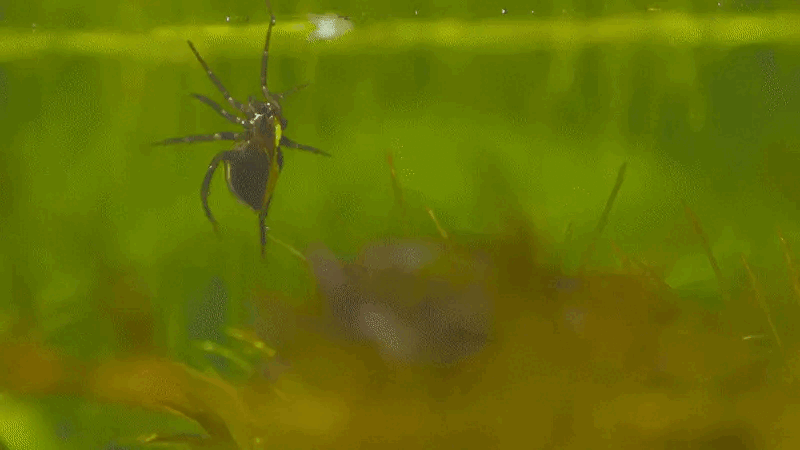
The spider swims back to the surface, continuing to spin silk to create a ladder.
At this point, the water-repellent hairs sticking out from its abdomen and body trap a layer of air around it. Taking advantage of the surface tension of the water, the spider creates a shiny silver air bubble around itself.
Then, it just needs to dive back to the bell like a child wearing a life jacket and release the air bubble. After several dives back and forth like this, the A. aquatica spider can fill its bell with air.
Now, it officially has a home underwater.
Dive bell spider (Argyroneta aquatica) – a spider that lives underwater
The Dive Bell Spider Can Stay Underwater All Day, as Its Home Functions to Absorb Oxygen from Water
This proves that A. aquatica is not just a diver; it is an engineer. Previously, scientists believed that the dive bells of A. aquatica could only provide enough oxygen for it to operate for about half an hour.
This meant that every 20 minutes or so, the A. aquatica spider would have to surface for air and transport a new load of oxygen back to its home.
But it turns out, scientists were mistaken.
In 2014, biologist Roger Seymour at the University of Adelaide, Australia, conducted a study observing the behavior of A. aquatica spiders and discovered that they can actually stay underwater all day.
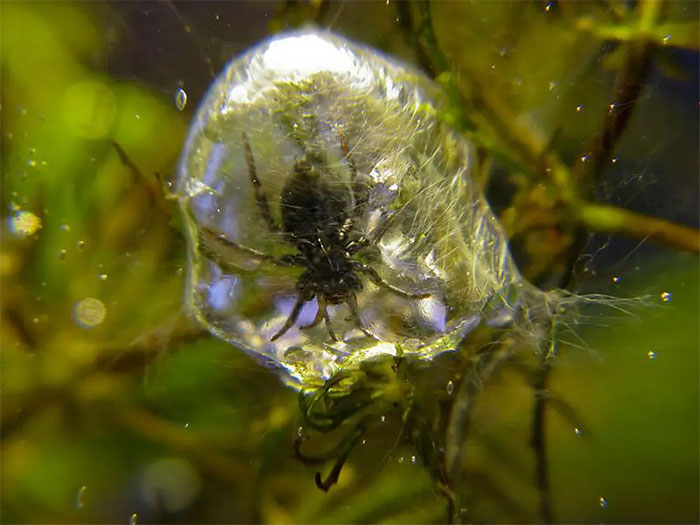
The silk bell of the A. aquatica spider functions to exchange oxygen with water like fish gills.
Seymour explained that the reason is that the silk bell itself functions to exchange oxygen with water like fish gills. “Because the bubble in the dive bell is held only by spider silk, most of its surface area is an interface between water, air, and the thin silk threads,” Seymour said.
“This allows oxygen to be exchanged between the water and the bubble.” A similar process occurs with the CO2 that the spider exhales. Gases simply diffuse from areas of high concentration to areas of low concentration.
Thus, when the bell has more CO2 and less oxygen, it will automatically take oxygen from the water and diffuse CO2 back out. “This mechanism can provide oxygen through the silk wall at a rate 8 times greater than the amount the spider brings down from the water surface,” Seymour stated.
Therefore, an A. aquatica spider can stay underwater all day.
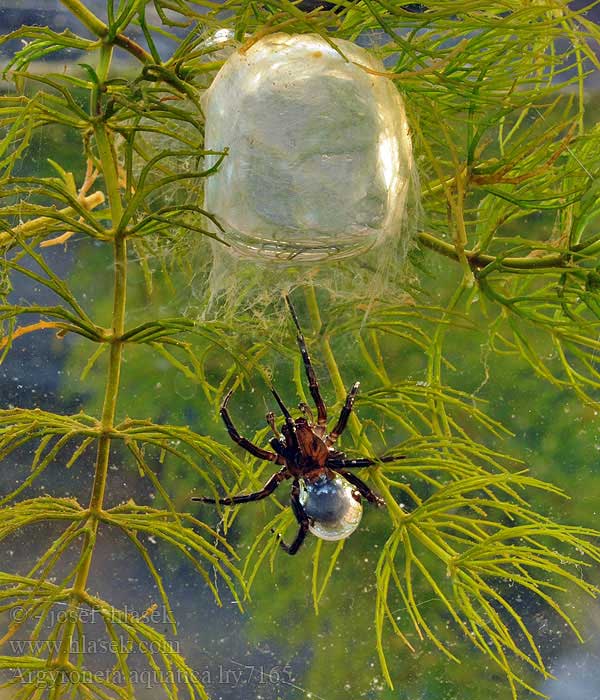
When the bell has more CO2 and less oxygen, it will automatically take oxygen from the water and diffuse CO2
And What Do They Do Down There… All Day?
Of course, a spider will spend most of its life spinning webs, setting traps, and waiting for prey. The A. aquatica spider itself is a fierce underwater hunter. It has enough venom to take down small fish and crustaceans that get caught in its web.
Typically, A. aquatica spiders will set traps around clusters of aquatic plants near their dive bells. Then, these spiders simply dip their rear ends into the dive bell and poke their heads out to observe.
In case you didn’t know, spiders breathe through openings located on either side of their thorax and abdomen called “book lungs” (because they open and close like the pages of a book).
They have tracheae that deliver oxygen directly to tissues and organs without needing to go through the head. Therefore, the A. aquatica spider can dip its abdomen into its bell and breathe while keeping its head exposed above water to observe prey.
Dive bell spider (Argyroneta aquatica) hunting underwater
When it spots prey caught in its trap, the A. aquatica spider will rush out of the bell and incapacitate it with a painful bite. Then, the spider will swim to the surface and transport more air down to expand its home, enough to set a larger dining table.
Once everything is prepared, the spider will pull its meal into the bell and begin to feast on the aquatic delicacy. On gloomy days when it cannot catch larger prey, the A. aquatica spider will nibble on aquatic larvae, just like its snacks.
With a Home and a Full Stomach, It’s Time to Find a Mate and Reproduce
This is the elegant life of the dive bell spider. There is one difference between this spider and those living on land: female A. aquatica spiders are usually smaller than males. Normally, female spiders are larger than males because they need to accumulate nutrients to lay eggs and care for their young.
However, for the purpose of laying eggs and caring for young, female A. aquatica spiders are smaller than males. This is because these spiders lay eggs and raise their young underwater. A smaller size means they have more room to lay eggs and more space for their offspring in their cramped bell.
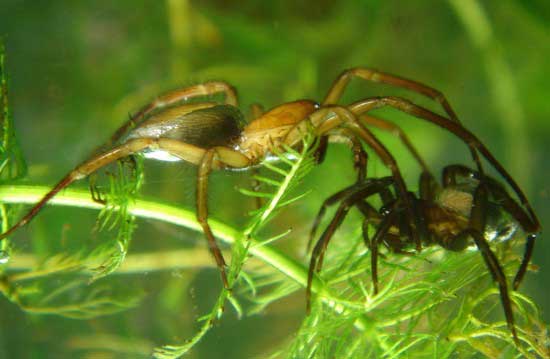
Female A. aquatica spiders are usually smaller than males.
The male diving bell spider, Argyroneta aquatica, on the other hand, must swim in the water to find a female spider. Therefore, it needs a larger body to swim more effectively. When a male A. aquatica detects the bell of a female spider, it begins to construct an additional “neighbor” bell nearby to start courting her.
Once the bell is completed, and the female spider becomes accustomed to the presence of her neighbor, the male A. aquatica will bore a tunnel from its new bell to the female’s home.
The two spiders will mate. After each mating session, the female A. aquatica will lay between 30 to 70 eggs. The eggs will hatch into spiderlings, which will begin their training for life underwater.
The diving bell spider (Argyroneta aquatica) conquers its mate underwater
Just a few weeks later, the young A. aquatica spiders are ready to separate from their mother. They will learn how to build diving bells, surface for air, and transport it down to create their own homes.
Thus, the life and lineage of the diving bell spider continue to thrive. They are conquering freshwater regions across Europe and Asia. So, the next time you see a silver spider underwater, not content to stay in trees but preferring to dive and weave webs to catch fish, remember that it is the diving bell spider, Argyroneta aquatica—a truly unique species on the planet.





















































